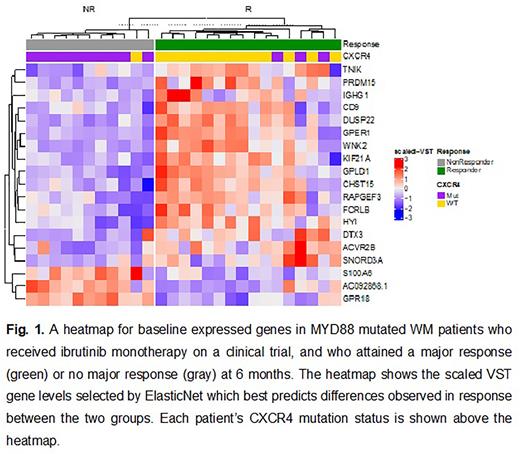Abstract
Background: Waldenstrom's Macroglobulinemia (WM) is characterized by recurring mutations in MYD88 (95-97%) and CXCR4 (40%). Mutated MYD88 activates HCK and BTK signaling which enable NFKB, SYK and ERK 1/2 pro-survival signaling, the latter related to BTK-inhibitor response and acquired resistance (Chen et al, Blood 2018). MYD88 and CXCR4 mutations also impact ibrutinib activity, including time to major response, depth of response and progression-free survival (PFS). Mutation testing for CXCR4 is challenging and can result in false negatives in up to 2/3 of WM patients by next generation sequencing (Gustine et al, BJH 2021). Moreover, CXCR4 mutations do not fully predict response activity to BTK-inhibitors. Attainment of a major response (>PR) by month 6 is a validated predictor for long-term PFS with ibrutinib (Castillo et al, BJH 2021). As such, we sought to identify biomarker(s) to predict response activity to ibrutinib using a multi-omic approach that could easily be adopted to the clinical setting.
Methods: We performed multi-omic sequencing using whole exome (WES), RNA-seq, methylome and ATAC sequencing in treatment-naïve, symptomatic MYD88 mutated WM patients who received ibrutinib on a prospective clinical trial (NCT02604511) with long-term follow-up (Treon et al, JCO 2018; Castillo et al, Leukemia 2022). CXCR4 mutation status was determined by AS-PCR and Sanger sequencing using CD19-isolated BM WM cells. Samples for multi-omic studies from 28 evaluable patients were collected at baseline. RNA-Seq reads were aligned to hg38 gencode v30 using the two pass STAR method for gapped alignment to the genome. Count based feature quantification was calculated using STAR. For ATAC-Seq, MACS was used to call peaks. Raw counts were used to run the default DESeq2 pipeline to obtain differentially expressed (DE) ATAC regions and transcripts between response groups using a l2fc > |1| and adj p of < 0.1 ElasticNet regression was then performed that included those differentially expressed transcripts and ATAC regions from the adjusted model using al2fc > |1| and adj p of < 0.1. The DE models were adjusted for gender, age and B2M.
Results: PFS was longer among patients attaining a major vs. non-major response at 6 months (median not reached vs 64.5 months; p=0.10). By whole exome sequencing, the only mutation that showed significant association with major response at 6 months was CXCR4 (p=0.002). Evaluable patients with mutated CXCR4 showed fewer major responses at 6 months (16.7% vs. 93%; p<0.0002) and had shorter PFS (36.4 mos. vs. NR; p=0.046) versus CXCR4 wild-type patients. While mutated CXCR4 associated with non-responders at 6 months and shorter PFS, 3/13 (23%) CXCR4 mutated patients were major responders at 6 months. By RNA-Seq, 64 DE genes were identified that included WNK2 (p=0.00005), DUSP22 (p=0.0008), GPER1 (p=0.0008) as the top hits expressed in CXCR4 wild-type and CXCR4 mutated major responders. Other DE genes identified by RNA-Seq in major responders included OSBPL3, PRDM15, GPLD1, GPR18, NEB, PPP1R3E, HYI, AC012368.1, WDR19, and DDR1. ATAQ-Seq revealed one significantly open genomic region at chr12 which mapped to the 5' region of the KIF21A locus, whose transcript was also DE between response groups. ElasticNet regression analysis using RNA-Seq and ATAC-Seq subjected to 500 bootstraps identified 20 transcripts, of which many are regulators of ERK1/2 signaling including WNK2, DUSP22, GPER1, TNIK, and PRDM15 (Fig. 1). Attainment of a major response at 6 months was strongly associated with expression of WNK2 (p=0.0043), as well as DUSP22, GPER1, TNIK and PRDM15 (all p<0.0001). Long-term PFS correlated with attainment of major response at 6 months for these biomarkers. Expression of WNK2 by IHC was validated in bone marrow biopsy samples to discern WNK2 expressors.
Conclusions: By use of comprehensive multi-omic genomics, we identified robust biomarkers for clinical investigation to predict ibrutinib major response at 6 months and long term PFS in MYD88 mutated WM patients that included many regulators of ERK1/2 signaling such as WNK2, GPER1, DUSP22, TNIK and PRDM15. Expression of these markers correlated with long-term PFS. The feasibility of using IHC to identify biomarker expression was demonstrated in this exploratory analysis, thereby providing a framework for clinical investigation of novel multi-omic identified genes as predictive biomarkers for BTK-inhibitors in WM.
Disclosures
Castillo:Cellectar: Consultancy; Roche: Consultancy; TG Therapeutics: Research Funding; Beigene: Consultancy, Research Funding; AstraZeneca: Research Funding; Abbvie: Consultancy, Research Funding; Pharmacyclics: Consultancy, Research Funding; Janssen: Consultancy. Sarosiek:ADC Therapeutics: Research Funding; BeiGene: Consultancy. Branagan:CSL Behring: Consultancy; BeiGene: Consultancy; Karyopharm Therapeutics: Consultancy; Adaptive Biotechnologies: Consultancy; Janssen/Pharmacyclics: Consultancy; Genzyme: Consultancy. Treon:Janssen/Pharmacyclics: Consultancy, Research Funding; BMS: Research Funding; BeiGene: Consultancy; Abbvie: Consultancy; X4: Consultancy, Research Funding.
Author notes
Asterisk with author names denotes non-ASH members.


This feature is available to Subscribers Only
Sign In or Create an Account Close Modal